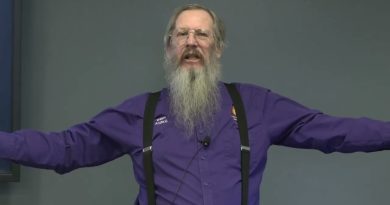Demystifying Hostnames and Domain Names in Linux, and How Server Naming Benefits You
Were you every confused regarding the differences and use-cases between a hostname and domain name for a device within your network? How does naming your servers benefit you? In this latest episode of the Linux Crash Course series, we’ll explore some foundational concepts around both.
*Support Linux Learning (commission earned)*
• Become a channel member here on YouTube ➜ https://learnlinux.link/join
• Become a Patron on Patreon ➜ https://learnlinux.link/patron
• Receive a 5% discount on an LPI exam voucher ➜ https://learnlinux.link/lpi-voucher
• Set up your own cloud server with Akamai Connected Cloud ➜ https://learnlinux.link/akamai
*Linux-related Gifts*
• Mastering Ubuntu Server 4th Edition (Jay wrote that!!! 😲) ➜ http://ubuntuserverbook.com
• Affiliate store for Linux compatible hardware/accessories ➜ https://learnlinux.link/amazon
• Awesome KVM for your Homelab ➜ https://learnlinux.link/tinypilot
*Individual Sections*
00:00 – Intro
01:15 – Set up your own Linux instance with Linode (Sponsor)
02:40 – Why it’s important to set the hostname for your Linux server
04:31 – How you go about finding the hostname for your Linux installation
05:24 – What exactly is a “hostname” anyway?
06:18 – What is a “domain name” and how does it differ from a “host name”?
09:59 – Example hostname and domain application within an organization
10:29 – Example “A Record” in DNS
12:01 – Expanding further on the differences between hostnames and domain names
15:03 – How does a domain controller fit in? Is it required?
*Recommended stand-alone videos from Learn Linux TV*
• How to create a bootable flash drive for installing Linux ➜ https://linux.video/flash-usb
• Installing an operating system for Raspberry Pi ➜ https://linux.video/pi-imager
• Understanding Linux permissions ➜ https://linux.video/perms
• Essential tweaks for ALL Linux Servers ➜ https://linux.video/all-servers
*Stand-Alone Tutorials*
• OpenSSH Guide ➜ https://linux.video/ssh
• How to better secure OpenSSH ➜ https://linux.video/secure-ssh
• 10 Linux Terminal Tips and Tricks to Enhance Your Workflow ➜ https://linux.video/cli-tricks-1
• Over 15 Terminal Tricks You Should Learn ➜ https://linux.video/cli-tricks-2
*Recommended Courses from Learn Linux TV*
• Get up to speed with managing an OpenStack Cloud ➜ https://linux.video/openstack
• Learn how to write your own Bash Scripts ➜ https://linux.video/bash
• Install, configure, and maintain a Proxmox VE Cluster ➜ https://linux.video/pve
• Automate tedious setup jobs by learning Ansible ➜ https://linux.video/ansible
• Learn how to exit vim (and use it too) ➜ https://linux.video/vim
*Linux-related Podcasts*
• Enterprise Linux Security ➜ https://enterpriselinuxsecurity.show
• The Homelab Show ➜ https://thehomelab.show
*Fun Linux-related Projects*
• Run your own Gitlab CE Server ➜ https://linux.video/gitlab
• Build a Kubernetes Cluster on Proxmox ➜ https://linux.video/pve-k8s
• Set up your own Nextcloud Server ➜ https://linux.video/nextcloud
*Official Learn Linux TV Sites*
• Main site ➜ https://www.learnlinux.tv
• Community ➜ https://community.learnlinux.tv
*FAQ*
• Which distro do I use? ➜ https://learnlinux.link/mydistro
• My recording gear (commissions earned) ➜ https://learnlinux.link/recording-stuff
Disclaimer: LearnLinuxTV provides technical content on YouTube that will hopefully be helpful to you and teach you something new. However, this content is provided without any warranty (expressed or implied). LearnLinuxTV is not responsible for any damages that may arise from any use of this content. The viewer is expected to follow best judgement and to make his/her/their best decisions while working with production or non-production systems and hardware.
#LinuxTraining #CloudComputing #DevOps
by Learn Linux TV
linux web server




Nice but too many ads
They are data objects or source if you don't care about author's right on data which is illegally obtained. I don't care about authors in this context.
As always, awesome explanation.
Love from INDIA. 🙏🏻
That's awesome video Jay. You are the coolest Linux teacher in the Universe. Respect from Poland.
hi, really interesting but got a thought
in case you do not have a domain controller. how do you then set it up so it finds the right server with domain requests
MS Domain controller AD is based on three software/protocols which Kerberos, LDAP and CIF (which is SMB and implemented in Samba in Linux). And they also usually have a DNS server, but that can also be another software in Linux.
(Use Kerberos for single sign on and verify machines AND users, LDAP for search databases for machine names and user names etc and CIF for send scripts to machine to set up software).
I can't post a link as an example or else my comment gets deleted, but why didn't he explain the concept of subdomains when discussing a FQDN? He mentions hostnames, and domain names, but not subdomains. Subdomains are the beginning part of a domain name, which is necessary for dynamic DNS, which is basically a domain name with a subdomain name in front.
i have struggled with this for a long long time!!
thank you for doing this video.
I install AD, because it is the best admin tool. After installation, I have the capabilities of a network device manager.
Crap video, too much sponsored content.
Hello there, is your playlist on how to configure Ubuntu server from the get go you uploaded few years ago not available anymore?
If you are working on a server in a terminal how do you know what the full domain name of that server is? Can it be displayed in the bash prompt as an alternative to the host name?
Can you explain assigning a fqdn without a domain controller?
This has answered so many questions I've had about domains! Please make more videos on this!
how do you download ct template from promox to pc if can how if no why can't it allow to download
I'm a hint disappointed in this video just cause I feel like I have more questions now.
Is the domain name for a computer set by the computer itself? Or by some network setting?
Sometimes after a reboot, the old hostname persists. I had to change the file /etc/cloud/cloud.cfg. There is a setting preserve_hostname: false. I had to change this to true and the new hostname survives a reboot.
Please make a video about Two-Factor Disk-Encryption, with Yubikey, FIDO2 or something like that.
I'm guessing an IT guy connected wrongly to the shinra server is probably what took down the midgar plate.
Thanks Jay.
That was the perfect balance and agree to going into no more detail than was strictly necessary without going off topic.